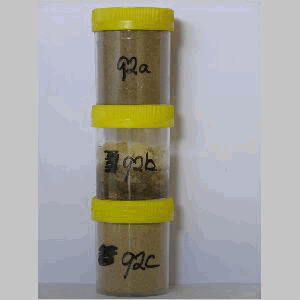Ross Sea Region Soil Sites
92000
92
15-Dec-1964
IBC, GGC
Head of Shackleton Glacier at Roberts Massif, Queen Maud Mountains, on the edge of the Polar Plateau
Soil characterisation
USGS 1:250 000 1968; Liv Glacier SV 1-10/5
B&W & CS Prof
No
177.1830
-85.5333
85deg 32.0'S
-177deg -11.0'E
| On the upper northwest slopes above the lower lying Roberts Massif basin; a high bench formed by Beacon group sediments with a thin cover of drift material; a flat smooth |
| surface |
0
Nil
2,400
cf. Notes for GEOLAND below
(0o)
Ultraxerous; no snow
-45
Inland mountain
Thin dolerite drift over sandstone
Nil observed
Weakly developed polygons on flattish sites
| SURFACE WEATHERING or |
| SURFACE FEATURES |
| Dolerite surface pebbles and boulders are strongly stained, well rounded and distinctly ventiform; some cavernous weathering (pitting) is present on upper |
| surfaces of clasts |
Nil
92 2-0cm
101
surface dolerite pebbles with loose granular sand
102
subrounded and strongly stained,
92a 0-5cm
201
yellowish brown (10YR 5/4) granular sand
202
loose to weakly cohesive
203
salt flecks diffused throughout
204
some dolerite rock particles strongly altered with distinct weathering rinds
205
sharp boundary,
92b 5-13cm
301
white (5Y 8/2) crystalline salt horizon
302
cohesive
303
sharp boundary,
92c 13-23cm
401
pale yellow (2.5Y 7/4) silty sand
402
cohesive
403
abundant salt flecks in patches
404
soil colour is light yellowish brown (2.5Y 6/4) where salt is absent, on sandstone rock
Yes
a,b,c
Dry frozen
0
5
Geoland
| Beacon group sediments outcrop in a few places but dolerite is the predominant rock type in the area; in places, the sediments are argillised and altered by |
| dolerite intrusion; where dolerite drift material is present, a soil cover has formed; where no dolerite drift is present, sandstone rock outcrops |
| Soluble Salt |
| Concentration |
9200001
92a
0-5cm
0
5
none
9200002
92b
5-13cm
5
13
none
9200003
92c
13-23cm
13
23
none
12-Dec-2005
Page 92 of 896
92
